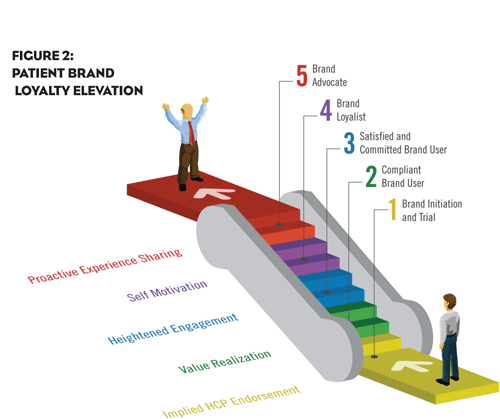It’s time for pharma marketers to break from tradition and rethink how we build insights into customers motivation, moving from focus groups to more natural, “organic” communities.
To a marketer, customer loyalty is hallowed ground—that rarified state where customer preference succinctly aligns with a brand’s perceived value or performance, fostering repurchase behavior while insulating the product from competitive alternatives. Creating (and even defining) customer loyalty in the pharmaceutical and healthcare verticals is challenging, though. Some would argue that chasing patient loyalty is an exercise in futility.
As patent expirations loom for a number of supernova drugs in the next year, industry experts estimate that brands with more than $30 billion in sales will face new competition from generics. In this environment, achieving 100% insulation from competition is probably a pipe dream. Pharmaceutical marketers can, however, realistically hope to increase brand loyalty by focusing on new methodologies for garnering customer insight, delivering value clearly aligned with identified customer needs, and, ultimately, inspiring loyalty and proactive customer advocacy.
IDENTIFYING LOYALTY MOTIVATORS
For years, brand marketers have promoted the concept that it costs less to retain loyal customers than replace them with new ones. Despite the inherent logic of this argument, the pharmaceutical industry has (historically) slighted brand loyalty. While our industry advances steadily in applying science and technology, we have let our tools for generating insights into customer loyalty get rusty, especially on the patient side of the equation. Enhancing patient loyalty begins with clear and relevant insight into motivation. It’s time to rethink how we obtain these insights—to reflect and leverage a digital-dominated, multi-channel customer environment. To make insights more actionable and relevant to loyalty-directed efforts, marketers will need to break from tradition.
“ARTIFICIAL INTELLIGENCE” VS. “ORGANIC INSIGHTS”
Traditionally, insight generation in the pharmaceutical industry has been dominated by focus groups, individual customer interviews, and anecdotal reports from a variety of internal sources. These research methodologies suffer from a common weakness: they produce customer insights out of context, in an artificial environment. Prior to the explosion of mobile and social technologies, the industry lacked any alternative ways to gather information. Researchers had to rely on face-to-face interviews and similarly obtrusive methods to glean insights into customer preferences and behaviors. Today, however, we have an opportunity to connect and engage with patients in their natural (organic) communities rather than a contrived research setting. These organic insights are commonly more actionable than traditional findings, and can produce deeper learning opportunities.
Organic insights derived across the digital space afford a stronger sense of anonymity among study participants, which can help eliminate typical response biases and other “accommodating” response strategies typical of face-to-face interviews. As anyone who has fielded an online study or checked out a popular review site can tell you, respondents tend to be unabashedly honest and direct in their responses to online survey questions, since they have no fear of retribution or “disappointing” the moderator. Depending on the nature of the study, online survey techniques also tend to target respondents in their natural behavioral environment (i.e., their homes), which helps strengthen the validity of data designed to capture true patient behavior and usage patterns. Today, brands can use social media— or at the very least, social principles—to produce insights organically. These insights come from individual users and communities who are active, responding in-context, and willing to interact with others about their shared experiences. We must become champions for minimizing reliance upon “artificial intelligence,” focusing instead upon producing organic insights via feedback through online communities and user surveys at a variety of touch points. Matched with behavior-oriented metrics (key performance indicators) and solid analyses, these organic insights define core customer needs, values, and attitudes toward the brand and brand experience.
SEEKING LOYALTY, STRIVING FOR ADVOCACY
Increasing patient loyalty has obvious commercial benefits—in retention, accrued sales, and ROI. But in an age defined by the rapid expansion of social media and consumerism, striving for patient advocacy arguably represents a higher order of achievement. The voices of experienced, satisfied, and self-motivated users of your brand are among the most powerful influences for driving adoption and loyalty. In several recent reports on their decision-making, patients ranked other patients’ testimonials among the most reliable sources of information. Keep in mind that advocacy often requires enablement—providing your most loyal users with an opportunity to tell their stories, share helpful tools, and express the value of their positive brand relationship.
DO LESS, BETTER: LESSONS FROM THE CONSUMER PRODUCTS INDUSTRY
The key to improving customer engagement—engagement that converts into loyalty and advocacy—is to focus on doing a few important things extraordinarily well. In the consumer products and services categories, companies such as USAA, Zappos, Edward Jones, and Disney have consistently demonstrated the value of addressing the most important customer needs. They base their approaches to customer engagement on exceeding expectations in a core set of high-value areas, while being open to, and consistently seeking, customer feedback. Not surprisingly, these companies have consistently outperformed the competition, have ranked at the top of JD Power & Associates rankings within their categories, and have transformed the accumulated advocacy of loyal users into growth and competitive insulation. The lesson to healthcare marketers is to avoid engaging in a value-add “arms race.” Instead, align customer support offerings with a few identified, high-value customer needs, and deliver these in a manner that is clearly better than the competition (Figure 1).
ELEVATING PATIENT LOYALTY TO MEDICINES
The equation for generating customer loyalty to medicines is a bit more ambiguous. In the relationship between patients and their medicines, a cascade of factors—including perceived therapeutic benefit, cost, support and access—intermingle with the influences of intermediaries such as prescribers, dispensers, payers, and educators. The takeaway from successful consumer programs is unchanged, however: to gain competitive insulation, pharmaceutical brands need to find and focus on the few things that really matter to customers. To gain greater insight into the drivers of patient loyalty toward pharmaceutical brands, we recently fielded a series of surveys of social media communities formed around specific chronic diseases, such as diabetes and cardiovascular disease. The objective was to understand how patients might define or experience loyalty to medicines, and to stratify the importance of a variety of activities and benefits associated with branded medicines.
Loyalty to medicines builds iteratively (Figure 2). Predictably, the first level of loyalty derives from the patient’s perception of the provider’s commitment to the therapy (“My doctor feels this is the best drug for me”). On the second level, trial and evaluation bring the patient to recognize the value of the therapy for its intended use (e.g., symptom relief). At the third level, the patient feels supported by the brand, and begins to identify him- or herself as a user of the brand. This level is experiential and engagement-based, and remains largely controlled by brand marketers. Thus, the brand experience is essentially becoming “the brand” to healthcare consumers. When we asked our research population to define loyalty-enhancing “support,” patient responses split among several categories of value propositions. For many, a brand that “allows easy access to information and resources” and “stays in touch with users” was likely to earn a higher degree of loyalty. Others saw coupons, discounts, and condition-management tools as catalysts for loyalty. Clearly, no single loyalty formula will deliver a lifetime customer or advocate, so constant insight generation—along with feedback and quantifiable data on user attitudes and actions—is the key to finding the loyalty sweet spot for your brand. This heightened engagement and perceived support elevates the patients’ level of self-motivation, perpetuating a tendency to personalize their relationship with the brand. Haven’t we all heard a friend or family member refer to a therapy as “my (brand)”? This level of personal identification usually indicates a potential brand advocate. Enabling patients to express this advocacy is increasingly valuable to healthcare brands.

LENGTHENING YOUR CUSTOMER ATTENTION SPAN
To achieve meaningful increases in patient loyalty, healthcare marketers must lengthen their engagement and investment perspective, stretching them beyond historical norms. Building and sustaining relationships is more than a “one and done” proposition. Generating advocacy, for certain, will require consistent outreach, enablement, and insight gathering. The long-range business potential of elevated loyalty and enabled advocacy are substantial, but will not be achieved without sustained commitment from marketers.









